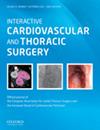氟脱氧葡萄糖-正电子发射断层扫描在预测局部晚期非小细胞肺癌新辅助放化疗后病理反应和预后中的作用
IF 1.6
4区 医学
Q3 CARDIAC & CARDIOVASCULAR SYSTEMS
引用次数: 1
摘要
目的本研究比较了氟脱氧葡萄糖正电子发射断层扫描(FDG-PET)和计算机断层扫描(CT)在预测局部晚期非小细胞肺癌(NSCLC)新辅助治疗后的病理反应和预后方面的应用价值。方法回顾性分析2008年至2019年在我院接受诱导放化疗(ICRT)和后续手术治疗的72例相邻结构受损伤和/或cN2 NSCLC患者。所有患者在ICRT前后使用相同的扫描仪和类似的技术进行FDG-PET和CT检查。我们计算了ICRT前后FDG-PET最大标准化摄取值(ΔSUVmax)和CT上肿瘤大小(ΔCT-size)的减少,并研究了病理反应与预后的关系。结果43例患者的疾病反应为主要病理反应,29例患者为次要病理反应。ΔSUVmax 60%和ΔCT-size 30%被确定为预测主要病理反应的最佳临界值。ΔSUVmax在敏感性、特异性、阳性预测值和阴性预测值方面均优于ΔCT-size。此外,ΔSUVmax预测预后优于ΔCT-size。基于本研究的结果,FDG-PET在预测局部晚期NSCLC患者ICRT后的病理反应和术后预后方面似乎比CT更有用。本文章由计算机程序翻译,如有差异,请以英文原文为准。
Role of fluorodeoxyglucose-positron emission tomography in predicting the pathological response and prognosis after neoadjuvant chemoradiotherapy for locally advanced non-small-cell lung cancer
Abstract OBJECTIVES The present study compared the utility of fluorodeoxyglucose-positron emission tomography (FDG-PET) and computed tomography (CT) for predicting the pathological response and prognosis following neoadjuvant therapy for locally advanced non-small-cell lung cancer (NSCLC). METHODS This retrospective analysis included 72 patients in whom adjacent structures showed involvement and/or cN2 NSCLC who received induction chemoradiotherapy (ICRT) and subsequent surgery at our hospital from 2008 to 2019. FDG-PET and CT were performed in all patients before and after ICRT using the same scanner with similar techniques. We calculated the reduction in the maximum standardized uptake value in FDG-PET (ΔSUVmax) and tumour size on CT (ΔCT-size) before and after ICRT and investigated the relationship between the pathological response and prognosis. RESULTS The disease response was classified as a major pathological response in 43 patients, and a minor response in 29 patients. ΔSUVmax 60% and ΔCT-size 30% were identified as the optimal cut-off values for predicting a major pathological response. ΔSUVmax was superior to ΔCT-size in terms of sensitivity, specificity, positive predictive value and negative predictive value. Furthermore, ΔSUVmax was superior to ΔCT-size for predicting the prognosis. CONCLUSIONS Based on the results of the present study, FDG-PET appeared to have greater utility than CT in predicting the pathological response following ICRT and the postoperative prognosis in patients with locally advanced NSCLC.
求助全文
通过发布文献求助,成功后即可免费获取论文全文。
去求助
来源期刊

Interactive cardiovascular and thoracic surgery
CARDIAC & CARDIOVASCULAR SYSTEMS-
CiteScore
3.30
自引率
0.00%
发文量
292
审稿时长
2-4 weeks
期刊介绍:
Interactive CardioVascular and Thoracic Surgery (ICVTS) publishes scientific contributions in the field of cardiovascular and thoracic surgery, covering all aspects of surgery of the heart, vessels and the chest. The journal publishes a range of article types including: Best Evidence Topics; Brief Communications; Case Reports; Original Articles; State-of-the-Art; Work in Progress Report.
 求助内容:
求助内容: 应助结果提醒方式:
应助结果提醒方式:


